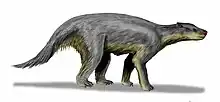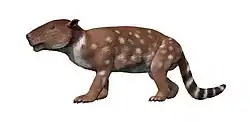Pantolambda
Pantolambda (Greek: "all" (pantos), "lambda" (lambda), in a reference to the shape of upper premolars, similar to the Greek letter lambda[3]) is an extinct genus of Paleocene pantodont mammal. Pantolambda lived during the middle Paleocene, and has been found both in Asia and North America.
| Pantolambda Temporal range: Paleocene, | |
|---|---|
 | |
| Scientific classification | |
| Domain: | Eukaryota |
| Kingdom: | Animalia |
| Phylum: | Chordata |
| Class: | Mammalia |
| Order: | †Pantodonta |
| Superfamily: | †Pantolambdoidea |
| Family: | †Pantolambdidae |
| Genus: | †Pantolambda Cope, 1882 |
| Type species | |
| †Pantolambda bathmodon Cope, 1882 | |
| Species[1][2] | |
| |
Cretaceous mammals, which had to compete with dinosaurs, were generally small insect eaters. Pantolambda was one of the first mammals to expand into the large-animal niches left vacant by the extinction of the dinosaurs. Pantolambda and other early pantodonts would quickly evolve into heavy animals such as Barylambda and Coryphodon. These were the first large browsers, pioneering styles of life later followed by many unrelated groups of mammals: rhinos, tapirs, hippos, ground sloths, and elephants.[4] Pantodonts such as Pantolambda were definitely not tree dwellers.
Description

Pantolambda was large for a Paleocene mammal, about the size of a sheep. A generalized early mammal, it had a vaguely cat-like body, heavy head, long tail and five-toed plantigrade feet ending in blunt nails that were neither hooves nor sharp claws. The foot bones articulated in a similar way to the feet of hoofed mammals, and the feet were probably not very flexible.
Teeth
The teeth had a selenodont structure; enamel ridges with crescent-shaped cusps. Selenodont teeth are found in modern grazers and browsers such as cattle and deer, but Pantolambda's teeth were low-crowned and indicate a not very specialized diet.[5] Pantolambda probably ate a mix of shoots, leaves, fungi, and fruit, which it may have supplemented with occasional worms or eggs.
Discovery and species

Fossils of this genus have been found in these Torrejonian-Tiffanian formations at the following localities of the United States:
- Pantolambda bathmodon — nicknamed "ManBearPig" (a reference to a creature from South Park) by some researchers, because it had "five-fingered hands, a bearlike face and the stocky build of a pig" [6][7]
- Sandoval County, New Mexico (35.7°N 107.0°W, paleocoordinates 42.1°N 87.1°W)[8]
- Pantolambda cavirictum
- Park County, Wyoming[9]
- San Juan County, New Mexico[10]
- Sandoval County, New Mexico[11]
- Carbon County, Wyoming[12]
- Fremont County, Wyoming[13]
- Pantolambda intermedium
- Hot Springs/Washakie County, Wyoming[14]
- San Juan County, New Mexico[15]
- Sweet Grass County, Montana[16]
References
- Pantolambda in the Paleobiology Database. Retrieved July 2013.
- "Pantodonta". After McKenna & Bell (1997) and Alroy (2002). Retrieved 2 November 2013.
- "Glossary. American Museum of Natural History". Archived from the original on 20 November 2021.
- Halstead, L.B., The Evolution of the Mammals, Peter Lowe, 1978.
- E. D. Cope (November 1884), "The Amblypoda", The American Naturalist, Vol. 18, No. 11
- Temming, Maria (13 September 2022). "Ancient 'ManBearPig' mammal lived fast — and died young". Science News Explores. Retrieved 6 April 2023.
- Ward, Cassidy (14 September 2022). "'ManBearPig' was real, and its fast lifestyle may have helped mammals thrive". SYFY WIRE. Retrieved 6 April 2023.
- Alamito Arroyo (Paleocene of the United States) in the Paleobiology Database. Retrieved July 2013.
- Rock Bench Quarry (Paleocene of the United States) in the Paleobiology Database. Retrieved July 2013.
- 44 Store (High) (Paleocene of the United States) in the Paleobiology Database. Retrieved July 2013.
- East Flank Torreon Wash (Upper) (Paleocene of the United States) in the Paleobiology Database. Retrieved July 2013.
- Boulder Quarry (UW V-94027) (Paleocene of the United States) in the Paleobiology Database. Retrieved July 2013.
- Shotgun (Paleocene of the United States) in the Paleobiology Database. Retrieved July 2013.
- MPG (Paleocene of the United States) in the Paleobiology Database. Retrieved July 2013.
- Chico Springs (Paleocene of the United States) in the Paleobiology Database. Retrieved July 2013.
- Gidley Quarry (Paleocene of the United States) in the Paleobiology Database. Retrieved July 2013.

